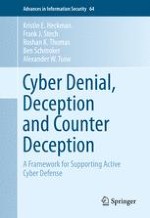This book presents the first reference exposition of the Cyber-Deception Chain: a flexible planning and execution framework for creating tactical, operational, or strategic deceptions. This methodology bridges the gap between the current uncoordinated patchwork of tactical denial and deception (D&D) techniques and their orchestration in service of an organization’s mission. Concepts for cyber- D&D planning operations and management are detailed within the larger organizational, business, and cyber defense context. It examines the necessity of a comprehensive, active cyber denial scheme.
The authors explain the organizational implications of integrating D&D with a legacy cyber strategy, and discuss trade-offs, maturity models, and lifecycle management. Chapters present the primary challenges in using deception as part of a security strategy, and guides users through the steps to overcome common obstacles. Both revealing and concealing fact and fiction have a critical role in securing private information. Detailed case studies are included.
Cyber Denial, Deception and Counter Deception is designed as a reference for professionals, researchers and government employees working in cybersecurity. Advanced-level students in computer science focused on security will also find this book useful as a reference or secondary text book.
